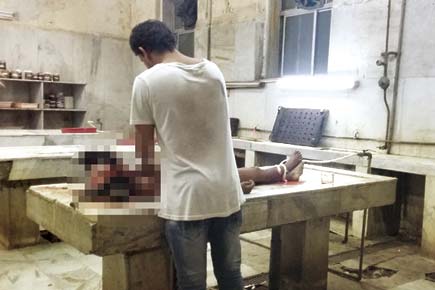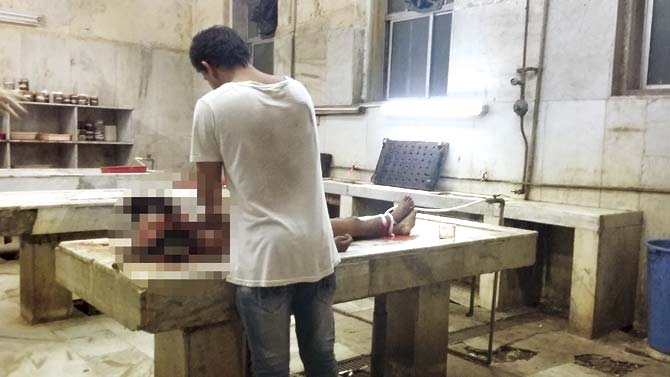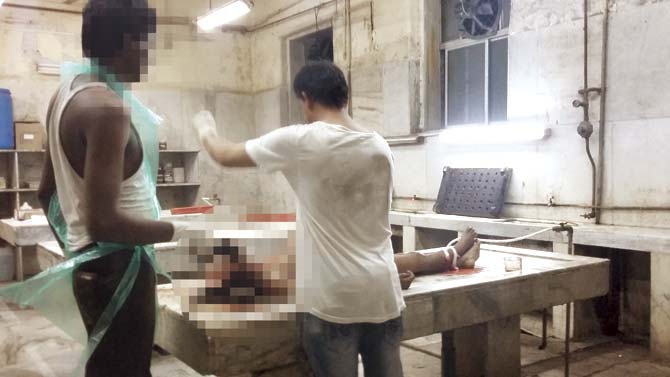The KEM Hospital continues to use 10 sweepers and an attendant to cut open the bodies, sew them up and handle the internal organs in their post-mortem centre, in blatant violation of all rules

Tune in to any crime series on television, and forensics is a big part of murder mysteries – fancy labs, top-notch equipment and celebrated experts are put to work to get to the bottom of the case.

This photo of a sweeper at KEM Hospital cutting a body open was sent to mid-day by a worker at the Parel hospital
Closer home, however, the truth is far different, as mid-day found out at KEM Hospital, which relies not on glamorous, highly-qualified experts but on sweepers barely educated past Std IV to carry out intricate post-mortems.

This picture, taken by a worker at KEM Hospital, shows two sweepers at work, stitching up a cadaver. In a case related to a Pune hospital, the Bombay High Court had ruled that safai kamgars are not qualified for such work
Open-and-shut case
KEM Hospital is the largest tertiary care medical unit in Mumbai, with one of the busiest morgues, conducting over 2,000 autopsies a year. Shockingly, these thousands of cadavers are cut open, their organs handled and then sewn up, all by 10 sweepers and a post-mortem-attendant-cum-sweeper (PMA).
This is in blatant violation of a Bombay High Court recommendation that only trained specialists, and not sweepers – or safai kamgars as they are commonly known - be permitted to perform post-mortem work.
Two years ago, one Sachin Laxman Jadhwar and other sweeper staff of Pune’s Yashvantrao Chavan Memorial Hospital (attached to the Pimpri-Chinchwad Municipal Corporation) placed a petition before the Bombay High Court, complaining that they were forced to undertake a part of the post-mortem work - opening and stitching of the dead bodies - even though this was not part of their official duties.
On October 7, 2013, the HC observed that the minimum qualification required for the post of a safai kamgar was only Std IV-pass. “Obviously, a person holding the said post has no knowledge of basic anatomy.
If such persons are forced to open the dead bodies and again stitch the dead bodies, there is every likelihood that while doing so they may cause damage to the vital parts of the human body, which may amount to destruction of evidence, especially in medico-legal cases,” said the bench headed by A S Oka and Revati Mohite Dere.
Cutting corners
At KEM, which continues to ignore this ruling, not only are the sweepers unqualified for such work, they are not compensated for it adequately. Officially, the hospital’s work manual does not even list post-mortems as a duty for the safai kamgars or the PMAs. In spite of this, they are pushed to do the work due to the lack of technical staff.
They are paid around Rs 8,000 per month, but this only covers their regular duties. Because there are no legal provisions for such a situation, these staffers do not even get proper rights, such as adequate compensation or insurance for the post-mortem duties, despite the obvious risk of infections.
Staffers complained that when they protest, hospital authorities simply point to one convenient clause in the work manual: staffers must do as instructed by seniors. “The rule is common for all employees, but that doesn’t mean that staffers have to do anything and everything.
Especially when Bombay High Court asked a Pune civic hospital to not allow safai kamgars to be a part of the post-mortem process. KEM Hospital’s standard operating procedure doesn’t supersede the High Court’s judgment,” said an employee at KEM.
Another KEM employee said, on the condition of anonymity, that the most discouraging part of the job is the stark imbalance between the risks involved and compensation offered. “We don’t get any insurance cover, being a Class IV employee.
While performing the post-mortems, if we suffer any lacerations which lead to infections, we pay for our own treatment. Then what is the point of carrying out this responsibility when technically it doesn’t even fit in our ambit,” he said.
‘It’s tradition’
When mid-day approached Dr Harish Pathak, the HOD of KEM’s forensic department, he said it would be wrong to say that safai kamgars conduct post-mortems. Instead, a better way to put it would be to say they assist forensic experts.
“We have one Post-mortem Attendant and 10 safai kamgars working as his assistants. The practice of safai kamgars opening the bodies, removing the organs and stitching it up has existed since years, and is followed around the country like an age-old tradition.
Now if we want to change this tradition, we need a government resolution to initiate a gradual transformation towards achieving better quality in the autopsies,” said Pathak.
Training
Pathak emphasised that instead of removing sweepers from the post-mortem process altogether, thereby crippling the field, it would be preferable to give them proper training as mortuary assistants, along with suitable benefits.
“Rather than looking for a revolution in the field by removing safai kamgars from the post-mortem process, a better way is to offer proper compensation and formal training. If any such course is initiated, our department will welcome and look forward to it,” he added.
Hardly cutting edge
In an ideal setup, a morgue would have to have a cutter to handle the bones, a mortuary assistant to make incisions and handle organs and a medical expert (apart from the support staff of sweepers, PMAs, etc).
However, a veteran autopsy expert was of the opinion that it is impossible for any post-mortem centre in the country to run without safai kamgars. “In India, we still use chini and hathodi (anvil and hammer) to break open the skulls and bones, while the rest of the world is far better equipped in the field of forensic science.
A single doctor can’t undertake the amount of work needed to conduct an autopsy; we need experts to assist him,” said the expert, adding, “However, we need a gradual change from the current setup, in which more likely than not, a few inebriated safai kamgars do the work of dissection, etc.”
 Subscribe today by clicking the link and stay updated with the latest news!" Click here!
Subscribe today by clicking the link and stay updated with the latest news!" Click here!









